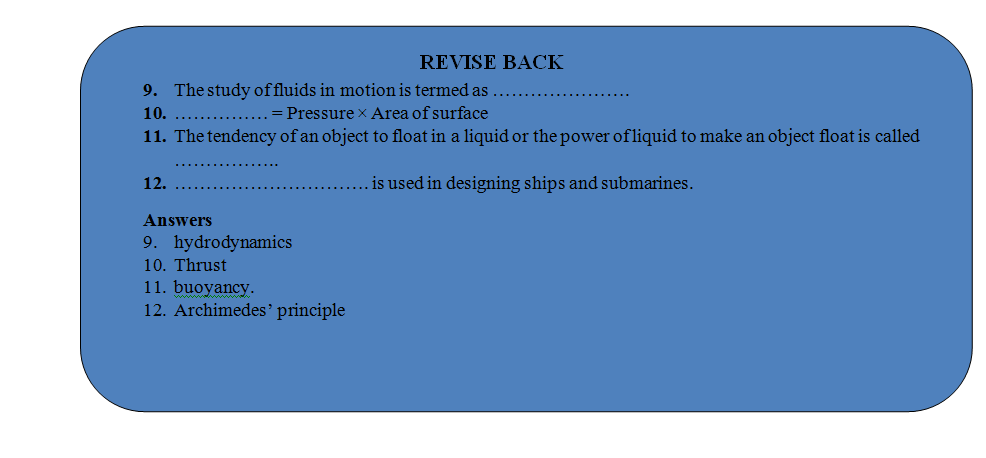
Mass and Weight
Gravitation of Class 9
The similarities and differences between mass and weight are discussed as follows :
MASS
The mass of a body is the quantity of matter contained in it.
Mass is a scalar quantity. The unit of mass is kilogram.
A body contains the same quantity of matter whether it be on the earth, moon or even in outer space. Thus, the mass of a body is constant and does not change from place to place.
Mass of a body is usually denoted by the small letter ‘m’.
Mass of a body is a measure of inertia of the body and hence it is also known as inertial mass. The mass of a body cannot be zero.
WEIGHT
We know that the earth attracts every object with a certain force and this force depends on the mass (m) of the object and the acceleration due to gravity (g).
The weight of an object is the force with which it is attracted towards the earth.
We know that, F = m x a
That is, F= m x g
The force of attraction of the earth on an object is known as the weight of the object. It is denoted by W.
So we have, W = m x g
As the weight of an object is the force with which it is attracted towards the earth, the S.I. unit of weight is the same as that of force i.e. Newton (N).
The weight is a force acting vertically downwards; it has both magnitude and direction, so it is a vector quantity.
The value of g is constant at a given place. Therefore at a given place, the weight of an object is directly proportional to the mass, say m, of the object, that is,W ∝ m . It is due to this reason that at a given place, we can use the weight of an object as a measure of its mass.
The mass of an object remains the same everywhere, that is, on the earth or on any planet whereas its weight depends on its location.
Difference Between Mass and Weight:
|
Mass |
Weight |
|
1. Mass is quantity of matter possessed by a body? |
1. Weight is the force with which a body is attracted towards the centre of the earth. |
|
2. It is a scalar quantity. |
2. It is a vector quantity. |
|
3. Its S.I. units is kilogram (kg.) |
3. Its S.I. unit is Newton (N). |
|
4. Mass of a body remains constant at all places |
4. Weight of the body changes from place to place. |
|
5. Mass of a body is never zero. |
5. Weight of a body becomes zero at the centre of the earth. |
|
6. Mass of measured by a beam balance. |
6. Weight is measured by a spring balance. |
Weight of a Freely Falling Body
Suppose a body is placed on a lift, the weighing machine will show the weight of the body on its scale. If now the lift is made to fall freely due to gravity, both the weighing machine as well as the body will fall with same acceleration i.e,, with g in the downward direction. The body will, therefore, not press the weighing machine with any force and hence show zero weight. Thus a body is weightless during free fall.
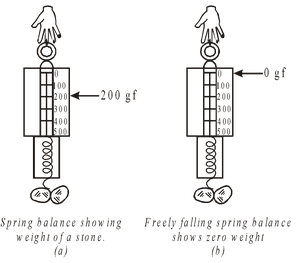
If a stone be suspended from the hook of the spring balance. Note its reading. Suppose it can be 200 g f. Release the spring balance along with hanging stone. Record the reading quickly as the stone is falling down. We shall find that the spring balance will show zero reading. Thus, stone under the condition of free fall experience weightlessness.
Weightlessness in space
Astronaut in a space ship orbiting the earth more than 1000 km above its surface. At that distance from the earth, the force of gravity of earth is still quite strong. Since the acceleration due to gravity is not zero, the weight of astronaut in the space ship certainly cannot be zero.
But we all have seen them on photographs and T.V.,they float in space ship and believe that in this situation they are weightless. This can be explained as follows:
When an astronaut in the space ship is orbiting the earth, then both, the astronaut and the spaceship are in a continuing state of free fall towards the earth with the same acceleration due to gravity.
Since the downward acceleration of the astronaut is the same as that of the spaceship he does not exert any force on the sides of the space ship and a weighing machine kept in the space vehicle will show his weight to be zero.
Though the free fall of a body produces a feeling of weightlessness but a true weightlessness can be experienced by a spaceship in a region of outer space where the acceleration due to gravity ‘g’ is zero.
Weight of an object on the moon:
- We have learnt that the weight of an object on the earth is the force with which the earth attracts the object.
- In the same way, the weight of an object on the moon is the force with which the moon attracts that object.
- The mass of the moon is less than that of the earth. Due to this, the moon exerts lesser force of attraction on objects.
- Let the mass of an object be m. Let its weight on the moon be Wm. Let the mass of the moon be Nm and its radius be Rm.
By applying the universal law of gravitation, the weight of the object on the moon will be

If the weight of the same object on the earth be W e . The mass of the earth is M and its radius is R.
Now,

Mass of earth = 5.98 x 10 24 kg
Radius of earth = 6 .37 x 10 6 kg
Mass of moon = 7.36 x 10 22 kg
Radius of moon = 1.74 x 10 6 m
Substituting the values:
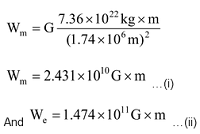
Dividing equation (i) by (ii), we get
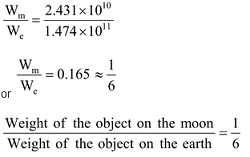
∴ Weight of the object on the moon = (1/6) × weight of the object on the earth.
Geo-stationary Satellite
It is an artificial satellite revolving around the earth with the following condition.
- It’s orbit lies in the equatorial plane of the earth.
- It reaches from west to east
- It’s time period of revolution is 24 hours.
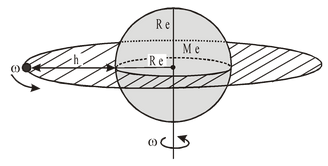
In this case T = 24 hour.
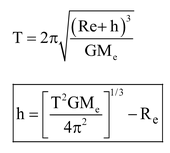
Related Topics
FLUID:
Fluid is a substance that flows under the action of an applied force and does not have a shape of its own. For example, liquids and gases. They take the shape of container in which they are stored.
The study of fluids at rest is known as hydrostatic or fluid static’s. The study of fluids in motion is termed as hydrodynamics. In this chapter, we will discuss the study of liquids only.
PRESSURE IN A FLUID:
In case of solids, the force can be applied in any direction with respect to the surface, but in liquids, the force must be applied at right angles to the liquids surface. This is because fluids (liquids and gases) at rest cannot sustain a tangential force. Therefore, we state the pressure acting on the fluid instead of force.
The pressure (P) is defined at the magnitude of the normal force acting on a unit surface area of the fluid. It a constant force of magnitude F acts normally on a surface area A, then pressure acting on the surface is given by P = F/A.
The pressure is a scalar quantity. This is because hydrostatic pressure is transmitted equally in all directions when force is applied, which shows that a definite direction is not associated with pressure.
THRUST:
The total force exerted by a liquid on any surface in contact with it is called thrust of the liquid.
Thrust = Pressure × Area of surface
UNITS OF PRESSURE:
In C.G.S. system, unit of pressure is dyne/cm 2 . S.I. unit of pressure is Nm -2 or Pascal (PA). The unit of pressure, Pascal (Pa) has been named in the honour of great French scientist and philosopher Blasie Pascal.
Another unit of pressure is atmosphere (atm).
1 atm = 1.013 × 10 5 Nm -2 (or Pa)
1 atm. or one atmosphere is the pressure exerted by our atmosphere on earth surface due to the weight of atmosphere.
Pressure is a Scalar Quantity:
Scalar quantities are those which do not have any direction. The physical quantities which have both magnitude and direction are called vector quantities.
Pressure is a scalar quantity because at one level inside the liquid, the pressure is exerted equally in all direction, which shows that a direction is not associated with hydrostatics pressure or pressure due to a static fluid.
Pressure Exerted by a Liquid Column:
Consider a liquid of density ρ contained in a cylindrical vessel of cross sectional area a. Let h be the height of liquid column and g be the acceleration due to gravity. The weight of liquid will exert a downward thrust on the bottom surface of the vessel. Therefore, pressure due to liquid acts on that surface.
Weight of liquid inside the vessel = volume × density of liquid × acceleration due to gravity
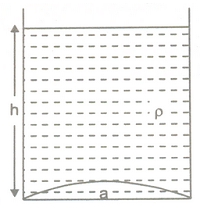
Thrust of liquid on area a = weight of liquid = a h ρ g
Liquid pressure on the base of vessel is
 …..(i)
…..(i)
NOTE TO REMEMBER:
- The liquid at rest exerts equal pressure in all direction s at a point inside the liquid.
- The liquid at rest exerts equal pressure at all those points which are in one level inside the liquid.
- Liquid pressure is independent of shape of the liquid surface, but depends upon the height of liquid column.
- Total pressure at a depth h below the liquid surface = P0 +hρg where P0 = atmospheric pressure.
- Pressure is a scalar quantity.
- Mean pressure on the walls of a beaker containing liquid upto height is (=hρg/2 ), where ρ is the density of liquid.
- Thrust exerted by liquid on the walls of the vessel in contact with liquid is normal to the surface of vessel.
BUOYANCY
To understand the term buoyancy, let us perform an activity :
Take an empty plastic bottle. Close the mouth of the bottle with an air tight stopper. Put it in a bucket filled with water.
- We will see that the bottle floats.
- Now push the bottle into the water. We will feel an upward push. If we push it further down, we will find it difficult to push deeper and deeper.
- This indicates that water exerts a force on the bottle in the upward direction.
- This upward force exerted by the water goes on increasing as the bottle is pushed deeper till it is completely immersed.
- If we release the bottle, it bounces back to the surface.
Explanation:
The force due to the gravitational attraction of the earth acts on the bottle in the downward direction. So the bottle is pulled downwards. But the water exerts an upward force on the bottle. Thus, the bottle is pushed upwards.
The weight of an object is the force due to gravitational attraction of the earth. When the bottle is immersed, the upward force exerted by the water on the bottle is greater than its weight therefore it rises up, when released.
To keep the bottle completely immersed the upward force on the bottle due to water must be balanced. This can be achieved by an externally applied force acting downwards. This force must at least be equal to the difference of upward force and the weight of the bottle.
The upward force acting on an object immersed in a liquid is called buoyant force or upthrust and this phenomenon of exerting buoyant force is called buoyancy.
Example:
- When a bucket is pulled out of a well, it is felt lighter so long as it remains immersed in water, inside the well. It acquires its actual weight when out of water.
- Ladies carrying water in a pitcher from a village pond, enter the pond, fill the pitcher and lift it on to their shoulder keeping it immersed in water.
Factors on which up thrust or buoyant force depends:
Let us perform the following two activates :
(i) Take two wooden blocks of different sizes. Push the small block inside the water in a tub and release it. You will find that the wooden block rises up and come to the surface of water. It rises up because upthrust or buoyant force acting on it is more than its weight.
Now push the large wooden block inside the water and release it. You will find that the large block rises up faster than the small block. It means, the upthurst or buoyant force acting on the large block is more than on the small block.
(ii) Now add some salt in water so that the density of solution (water + salt) increases. Push a wooden block inside the solution and release it. You will find that the block rises up faster in a solution than in pure water. It means, the upthrust or buoyant force acting on a body is more in a liquid having more density than in a liquid having less density.
Conclusion:
From the above mentioned actives, we conclude that upthrust or buoyant force depends on :
- The size or volume of the body immersed in a liquid.
- The density of the liquid in which the body is immersed.
Buoyancy:
The tendency of an object to float in a liquid or the power of liquid to make an object float is called buoyancy.
Remember these points:
- An object whose weight (i.e., downward gravitational force) is greater than the upthrust of the liquid (say water) on the object, sinks in the liquid. This is possible if density of object is more than the density of liquid.
- An object whose weight (i.e. downward gravitational force) is less than the upthurst of the liquid on the object, floats on the liquid. This is possible if density of object is less than the density of liquid.
ARCHIMEDES’ PRINCIPLE:
Archimedes was a Greek scientist. He discovered the principle, subsequently named after him, after noticing that the water in a bath tub overflowed when he stepped into it. He ran through the streets shouting “Eureka”! which means “I have got it”.
This knowledge helped him to determine the purity of the gold in the crown made for the king. This work in the field of geometry and mechanics made him famous. His understanding of levers, pulleys, wheels–axle helped the Greek army in its war with roman army.
“Archimedes’ principle states that when a body is partially or wholly immersed in a liquid, it experiences an upward force that is equal to the weight of the fluid displaced by it.
Activity to understand Archimedes’ principle:
- Take a piece of stone and tie it to one end of a rubber string or a spring balance.
- Suspend the stone by holding the balance or the string as shown in figure below.
- Note the elongation of the string or the reading on the spring balance due to the weight of the stone.
- Now, slowly dip the stone in the water in a container. You will find that the elongation of the string or the reading of the balance decreases as the stone is gradually lowered in the water.
- However no further change is observed once the stone gets fully immersed in the water.
Explanation:
The elongation is produced in the string or the spring balance due to the weight of the stone. Since the extension decreases once the stone is lowered in water, it means that some force acts on the stone in upward direction.
As a result, the net force on the string decreases and hence the elongation also decreases. This upward force exerted by water is known as the force of buoyancy.
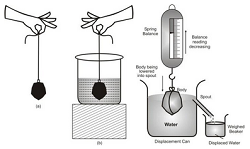
Applications of Archimedes’ principle
- Archimedes’ principle is used in determining the relative density of a substance.
- The hydrometers used for determining the density of liquids are based on Archimedes’ principle.
- The lactometers used for determining the purity of milk are based on Archimedes’ principle.
- Archimedes’ principle is used in designing ships and submarines.
Why objects float or sink in a liquid?
When an object is put in a liquid, then two forces act on it :
- Weight of object acting downwards due to the gravitational pull of the earth on the object.
- Buoyant force acting upwards which tends to push the object up.
Sinking of an object in water:
If we place an iron nail on the surface of water in a beaker then the nail sinks. The force due to the gravitational attraction of the earth on the iron nail pulls it downwards. There is an upthrust of water on the nail, which pushes it upwards. But the downward force acting on the nail is greater than the upthrust of water on the nail, so it sinks. An object will sink in a liquid if its density is more than that of the liquid.
Floating of an object in water :
If we place a piece of cork on the surface of water in a beaker, then the cork floats. This happens because of the difference in their densities. The density of a cork is less than the density of water. This means that the upthrust of water on the cork is greater than the weight of the cork. So, it floats.
Therefore, objects of density less than that of a liquid float on the liquid. The objects of density greater than that of a liquid sink in the liquid.
DENSITY
The ratio of mass and volume of the body is known as the density of the material of the body.
Density = Mass/Volume
ρ = M/V
IF V = 1 m 3 , then, ρ = M
or the mass per unit volume is known as the density of the material of the object.
Unit of density :

∴ ρ → kg/m 3 (in S.I. system)
RELATIVE DENSITY OR SPECIFIC GRAVITY
The ratio of density of the substance to the density of water at 4 0 C is known as the relative density of the substance.
Relative density of substance =

It is pure number having no unit.
Question: The relative density of silver is 10.5. The density of water is 10 3 kg/m 3 . What is the density of silver in S.I. unit ?
Solution: Density of water dw = 10 3 kg/m 3
Relative density (R.D.) of silver = 10.5
Density of silver dAg= ?

∴ dAg = 10.5 × 10 3 kg/ m 3 .
USES OF ARCHIMEDES PRINCIPLE
Relative density for solids and liquids can also be determined with the help of Archimedes principle.
(i) For solids :
By definition, we have
Relative density =

Relative density =

Relative density of a solid can be measured by weighing it first in air and then when fully immersed in water.
Let weight of the body in air = W1
Weight of solid body in water = W2
∴ Loss in weight = W1 - W2
∴

(ii) For liquids :
To measure relative density of a liquid, choose a body which can be fully immersed in water as well as in the given liquid. The body is weighed first in air, then fully immersed in water and then fully immersed in that particular liquid.
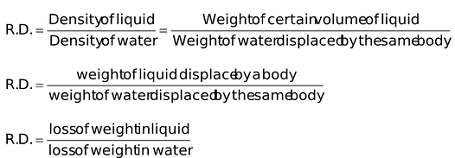
Let the weight of a body in air = W
Weight of the body fully immersed in water = W’
Weight of the body fully immersed in liquid = W’’
Then loss of weight in liquid = W - W’’
and loss of weight in water = W - W’
∴ Relative density of the liquid =

Archimedes principle is used to design :
- The ships and submarines.
- The hydrometers to find the densities of liquids.
- The lactometers to test the purity of milk.
Tale of densities and relative densities of some substances:
|
S.No. |
Name of Substance |
Density at S.T.P. in (kg m -3 ) |
Relative Density |
|
1 |
Air |
1.29 |
1.29 × 10 -3 |
|
2 |
Wood |
800 |
0.80 |
|
3 |
Ice |
920 |
0.917 |
|
4 |
Water |
1000 |
1.00 |
|
5 |
Glycerin |
1260 |
1.26 |
|
6 |
Glass |
2500 |
2.50 |
|
7 |
Aluminium |
2700 |
2.70 |
|
8 |
Iron |
7900 |
7.90 |
|
9 |
Silver |
10500 |
10.50 |
|
10 |
Mercury |
13600 |
13.60 |
|
11 |
Gold |
19320 |
19.32 |
PHYSICAL MEANING OF RELATIVE DENSITY:
Relative density of a substance is a number of times the given substance is heavier than the equal volume of water. When we say that the relative density of silver = 10.5, it means, silver is 10.5 times heavier than equal volume of water.
LAW OF FLOATATION:
Law of floatation is an extension of Archimedes principles.
When a body is immersed partially or wholly in a fluid, then the various forces acting on the body are (i) upward thrust (B) acting at the centre of buoyancy and whose magnitude is equal to the weight of the liquid displaced and (ii) the weight of the body (W) which acts vertically downwards through its centre of gravity.
- When W > B, the body will sink in the liquid.
- When W = B, then the body will remain in equilibrium inside the liquid.
- When W < B, then the body will come upto the surface of the liquid in such a way that the weight of the liquid displaced due to it balance the weight of body immersed inside the liquid.
Thus law of floatation is defined as follows :
Definition:
A body floats is a liquid if weight of the liquid displaced by the immersed portion of the body is equal to the weight of the body.
Relation between Density of Solid and Liquid :
Let ρ 1 be the density of the solid whose volume if V 1 . Let ρ 2 be the density of the liquid and the volume of the portion of the solid immersed in the liquid be V2.
Now, weight of the floating solid = weight of the liquid displaced.
i.e.

or

= Fraction of volume of body immersed in liquid
